Related Research Articles
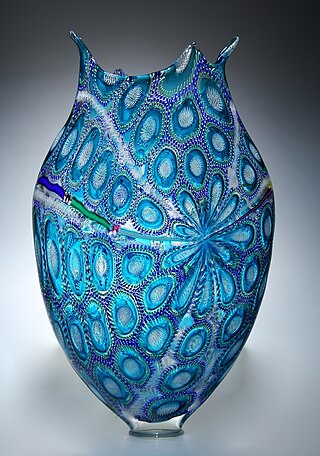
Studio glass is the modern use of glass as an artistic medium to produce sculptures or three-dimensional artworks in the fine arts. The glass objects created are intended to make a sculptural or decorative statement, and typically serve no useful function. Though usage varies, the term is properly restricted to glass made as art in small workshops, typically with the personal involvement of the artist who designed the piece. This is in contrast to art glass, made by craftsmen in factories, and glass art, covering the whole range of glass with artistic interest made throughout history. Both art glass and studio glass originate in the 19th century, and the terms compare with studio pottery and art pottery, but in glass the term "studio glass" is mostly used for work made in the period beginning in the 1960s with a major revival in interest in artistic glassmaking.
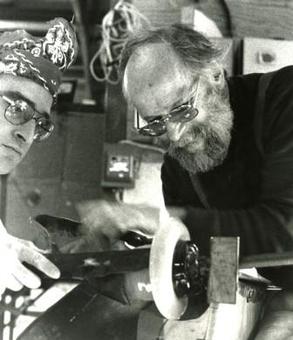
Harvey Littleton was an American glass artist and educator, one of the founders of the studio glass movement; he is often referred to as the "Father of the Studio Glass Movement". Born in Corning, New York, he grew up in the shadow of Corning Glass Works, where his father headed Research and Development during the 1930s. Expected by his father to enter the field of physics, Littleton instead chose a career in art, gaining recognition first as a ceramist and later as a glassblower and sculptor in glass. In the latter capacity he was very influential, organizing the first glassblowing seminar aimed at the studio artist in 1962, on the grounds of the Toledo Museum of Art. Imbued with the prevailing view at the time that glassblowing could only be done on the factory floor, separated from the designer at his desk, Littleton aimed to put it within the reach of the individual studio artist.
Josiah McElheny is an artist and sculptor, primarily known for his work with glass blowing and assemblages of glass and mirrored glassed objects. He is a 2006 recipient of the MacArthur Fellows Program. He lives and works in New York City.

Lino Tagliapietra is an Italian glass artist originally from Venice, who has also worked extensively in the United States. As a teacher and mentor, he has played a key role in the international exchange of glassblowing processes and techniques between the principal American centers and his native Murano, "but his influence is also apparent in China, Japan, and Australia—and filters far beyond any political or geographic boundaries."
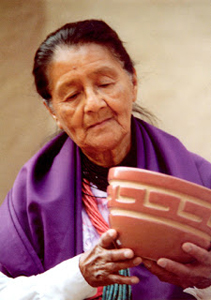
Maria Margarita "Margaret" Tafoya was the matriarch of Santa Clara Pueblo potters. She was a recipient of a 1984 National Heritage Fellowship awarded by the National Endowment for the Arts, which is the United States government's highest honor in the folk and traditional arts.

The Corning Museum of Glass is a museum in Corning, New York in the United States, dedicated to the art, history, and science of glass. It was founded in 1951 by Corning Glass Works and currently has a collection of more than 50,000 glass objects, some over 3,500 years old.

Dante Marioni is an American glass artist.

Richard "Dick" Marquis is an American studio glass artist. One of the first Americans ever to work in a Venetian glass factory, he became a master of Venetian cane and murrine techniques. He is considered a pioneer of American contemporary glass art, and is noted for his quirky, playful work that incorporates flawless technique and underlying seriousness about form and color.
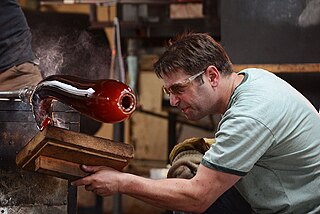
David Scott Patchen is an American glass artist who uses the techniques of cane and murrine in an American style. Patchen's work is internationally known primarily for a combination of intricately patterned and vibrant color combinations in large scale blown glass. His work is in many private and public collections, featured in many publications and frequently in shows such as SOFA, Chicago, ART Shanghai, COLLECT London and ART Palm Beach. His work is shown in galleries and in museums in the U.S., and Europe. Patchen was awarded an artist residency in 2010 in Seto city, Japan where his visit was covered by the local media and included lectures, demonstrations and a show of his work at the Seto City Art Museum. Based on Patchen's expertise, his book is part of the permanent collection of Giorgio Cini Foundation's Centro Studi del Vetro library in Venice, Italy and the Rakow Library at the Corning Museum of Glass.
Teri Greeves is a Native American beadwork artist, living in Santa Fe, New Mexico. She is enrolled in the Kiowa Indian Tribe of Oklahoma.

Karen LaMonte is an American artist known for her life-size sculptures in ceramic, bronze, marble, and cast glass.
Alfred H. Qöyawayma is a Hopi potter and bronze sculptor. He was born in Los Angeles on February 26, 1938. Qöyawayma is also a mechanical engineer who has worked in the development of inertial guidance systems and a co-founder of the American Indian Science and Engineering Society.
Katherine Gray is a Canadian glass artist and professor of art at California State University, San Bernardino. Her work includes vases, candelabras, and goblets, and some of her pieces are designed to fit inside each other.
Rebecca Salsbury James (1891–1968) was a self-taught American painter, born in London, England of American parents who were traveling with the Buffalo Bill Wild West Show. She settled in New York City, where she married photographer Paul Strand. Following her divorce from Strand, James moved to Taos, New Mexico where she fell in with a group that included Mabel Dodge Luhan, Dorothy Brett, and Frieda Lawrence. In 1937 she married William James, a businessman from Denver, Colorado who was then operating the Kit Carson Trading Company in Taos. She remained in Taos until her death in 1968.
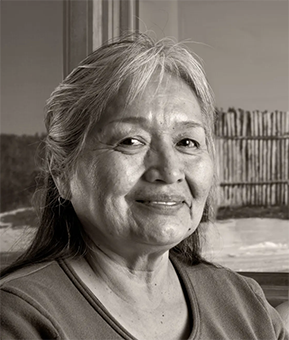
Christine McHorse, also known as Christine Nofchissey McHorse, was a Navajo ceramic artist from Santa Fe, New Mexico.
Susan Folwell is a Native American artist from Santa Clara Pueblo, New Mexico, known for her work in the ceramic industry. Her work ties in Native designs and history and has been used by Folwell to demonstrate her viewpoints on society and politics. Folwell has been described by the Heard Museum as an "innovator in Pueblo pottery".
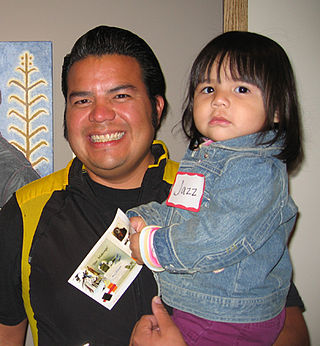
Jason Garcia is a contemporary Native American artist in the United States, who was born in Santa Clara, New Mexico. His work has been exhibited the Smithsonian in Washington D.C, the Heard Museum in Phoenix, the Palm Springs Art Museum, and many more. He won the 2018 Mentor Fellowship Award under the Native Arts and Cultures Foundation amongst many others.

Deborah Czeresko is an American glass blower known for winning the first season of the Netflix series, Blown Away.
Cobi Cockburn is an Australian glass artist.
Ann Morhauser is an American glass artist based in California. She is the founder of Annieglass, a glassware, tableware and glass sculpture company. Her work is held in the permanent collection of the Smithsonian American Art Museum. In 2022, she was recognized as the Santa Cruz County Artist of the Year.
References
- 1 2 3 "Mazzo Sporgente (Leaning Bouquet)". Corning Museum of Glass.
- ↑ Wildlife Art Magazine May/June 2005
- ↑ "My Third Arid Dream". LACMA.
- 1 2 Ohuma, Keiko (Fall 2010 – Winter 2011). "Dangerous Bounty Flo's seductive glass art often includes spikes". Trend Art+Design+Architecture: 98–99.
- ↑ Lucartha., Kohler (2003). Women working in glass. Atglen, PA: Schiffer Pub. ISBN 0764318071. OCLC 51931104.
- ↑ Miro, Marsha (Fall 1997). "Flo Perkins". Urban Glass: 61.
- ↑ Billingsley, Eric (Fall 2005). "Flo Perkins "New Work"". The Urban Glass Art Quarterly. 68: 60.
- ↑ Chambers, Karen (Winter 1987). "Flo Perkins". New York Glass. 28: 23.
- ↑ Anderson, Kathie (Spring 1997). "Flo Perkins". AmericanStyle. 3: 21.
- ↑ Bernstein, Ruby (1991). "Four on The Floor: The Steuben Competition Winners". The Glass Arts Society (Journal).
- ↑ "Flo Perkins". The Glass Art Society Journal: 27th Annual Conference Global Glass Tucson, Arizona: 60. 1997.
- ↑ "Artists' News". Art Alliance for Contemporary Glass (Newsletter). 4: 10. Spring 2010.